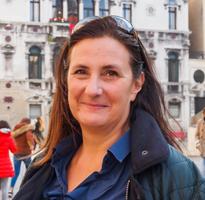As somewhat of a train enthusiast, I was thrilled when I was given the opportunity to experience 'La Robla', a train cruise in Cantabria, Northern Spain. We were to combine this short cruise with an exploration of Santander, Bilbao and then Madrid and the from here planned to take the famous 'Trenhotel' home to Paris, then the Eurostar to London. As inexperienced continental drivers, this rail trip allowed us to take in dramatic scenery and multiple destinations without the hassle of driving and at the same time indulged our love of all things Spanish and my love of rail travel.
The main reasons to visit this region are art, cuisine and spectacular scenery. The Basque city of San Sebastian has numerous Michelin stars and Bilbao and Santander are not far behind with their locally sourced, delicious yet simple food. We began in Santander which is a gateway to the region and offers a small, charming old town and stunning sandy beach. Despite the chill of November, the wide, flat beach was full of surfers and the locals were enjoying their lunch time wine and tapas, spilling out of small eateries into the narrow streets. We visited the historic Real hotel, just outside of the city centre, which offers a sophisticated atmosphere and views over the coast. We had a late dinner of clam casserole and wine before our trip by private Kirker transfer to Bilbao the next day.
The drive along the coast between the two cities revealed green, rolling hills, small sandy coves and wide-ranging agriculture. Bilbao comes as a pleasant shock to the system with cutting-edge, glassy, modern architecture surrounding the legendary Guggenheim Museum. Whilst not usually modern art fans, we were soon won over by the variety of works on offer and the light, fun atmosphere of the building. The two hotels we offer, The Artist Grand hotel of Art and the Miro, are located just opposite and match the contemporary style of the museum. We regretted not having longer to experience the buzzing city with a thriving art, music and theatre scene and fantastic restaurants. As we had some of the famous snacks, pinchos, in the sunshine of the old town square, we reflected that this would be next on our list for a sophisticated, cultural break.
After lunch we made our way to the historic, tile-clad Bilbao Feve station for the afternoon departure of La Robla. Feve is a state-owned company operating narrow-gauge rail lines in the North of the country. They own the Trenes Touristicos del Norte which operate the Tanscantabrico and La Robla.
There are several different itineraries on offer; we're to travel on the three-night round-trip from Bilbao to Leon and back. At check-in we received the obligatory glass of cava whilst we received our multi-lingual welcome talk and our bags were whisked away to our cabin. We were lucky enough to have a cabin each which allowed us a lot more space. Whilst small and perfectly formed, for two people the cabins would be a bit of a squeeze. Nevertheless, the beds are comfortable and the en suite bathrooms had round-the-clock hot water, fresh towels and good storage. After a quick freshen-up and a sunset journey on the train, we made our way by luxury coach to the Parador of Fuentes Carrionas for a delicious, communal dinner. Whilst mostly Spanish, the guests on board were of a mixture of ages and backgrounds and after a couple of glasses of wine and some Chupitos or digestifs, the group soon overcame their initial reticence. The rest of the trip passed with easy conversation and a convivial atmosphere.
The train stops at night, allowing for a good night's sleep and starts to move just before your alarm call. Opening the curtains at the foot of my bed to find us skirting the Picos de Europa National Park in the dawn light, was a highlight of the entire trip. The weather and scenery here are less predictable than the warmer south and as we headed inland towards Leon, the temperatures dropped and the snow fell. This only served to enhance the wild and rugged terrain and suited the warm, rustic food we were welcomed with. Breakfast is, thankfully, light and varied and taken at your own pace in the dining car. After breakfast each day there is an excursion on the coach, a lunch outside of the train and an afternoon siesta back on board. It is a very civilised, and very Spanish, timetable. Highlights of the tour included the Ojo de Guare a caves, which house an entire chapel within the cave complex and a guided walking tour of the Castillian city of Leon. Some of the city's most prominent historical buildings are the Cathedral, the finest example of French-style classic Gothic architecture in Spain, the Basilica of San Isidoro, one of the most important Romanesque churches in Spain and resting place of Leon's mediaeval monarchs, the Monastery of San Marcos, a prime example of plateresque and Renaissance Spanish architecture, and the Casa Botines, a Modernist creation of the architect Antoni Gaudi. A noteworthy example of modern architecture is the city's Museum of Contemporary Art or MUSAC. The Parador of Leon is one of the most interesting hotels I have ever visited and is a living, breathing museum piece.
Bidding farewell to our travel companions, we took the Spanish AVE service to Madrid, settling into our comfortable seats even in second class.
Madrid proved to be a city of many surprises. Despite being a major European capital, the centre is clean, compact and well-organized. I visited the fascinating Thyssen and Prado Museums but barely scratched the surface of the city's cultural offering. There are an abundance of parks and open spaces to enjoy their mild climate and a seemingly endless choice of bars and restaurants when the sun goes down. The Madrilenos are notorious for late night eating and drinking and to have some tapas at La Trucha whilst watching the hustle and bustle is a truly Spanish experience.
After our whirlwind tour of Madrid, it was time to travel back over land to London. We departed Madrid Atocha in our comfortable Gran Classe sleeper cabin on the Trenhotel. Whilst again small and somewhat lacking in storage space, it had bunk beds, an en suite bathroom with shower and, as part of the package, included our dinner and breakfast. A porter helped us with our bags and collected our passports ready for the border-crossing during the night. He also booked our early sitting for dinner, which is held in the modern restaurant car. We weren't expecting the 3-course a la carte selection to be quite so tasty and it made for a very civilized start to the journey. After dinner we relaxed in the on-board bar before a good nights' sleep in crisp linen. The Trenhotel arrives into the Gare D'Austerlitz in Paris and the Kirker transfer to take us directly to the Gare du Nord was most welcome after the long journey. The next, quick, step of the journey was the Eurostar to London meaning we were home in the centre of town before lunch time.































